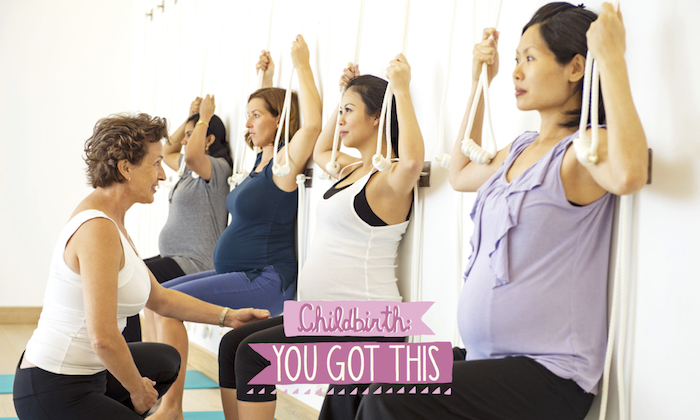

Are you pregnant and not sure what to expect from childbirth? Or perhaps it’s not your first time at the rodeo but your initial experience was an unpleasant one that you don’t care to repeat.
When I heard about the unique “Role Play of Child Birth“ workshop offered later this week at Como Shambhala Urban Escape, I was quite curious (and a bit amused imagining convincing my husband to do this kind of role play!). But after chatting with course instructor Sarah Manning, an experienced prenatal yoga teacher who’s been working with couples on labour and childbirth strategies for nearly 20 years, consider me a convert mama! Read on for more on what you can expect to get out of the workshop (also offered in May), along with some of Sarah’s expert wisdom and advice on how to prepare for YOUR best possible birth experience.


I was living in Singapore and pregnant with my second child when I did my teacher training through the International Yoga Teachers Association – a non-profit yoga teacher training organisation based in Sydney. It involved a yearlong remote study of anatomy, history, philosophy, planning, precautions – as well as the opportunity to practice around the ever growing bump.
Singapore-based Anjani Shah, an extraordinary Iyengar teacher then, guided me through pregnancy, honouring yoga postures and variations. My practical exams in Sydney were fitted around due dates! So it made sense to start teaching pregnant woman once qualified in 1995.
I started prenatal classes at the Work Sanctuary, then Mother & Child was launched by Glenys Quayle and I teamed up with her, teaching prenatal yoga. It was pregnant students of these classes who asked me to teach their husbands some of these non-medical pain management techniques so 18 years ago, working with the midwives, we pulled together a consistent handout and teaching material for the couples role play workshops —breathing, positions for labour, useful relaxation skills.
Is there an ideal time in the pregnancy (third trimester? 30 weeks onward? etc.) when couples can get the most out of this class?
The third trimester is ideal as this is when women are bigger and more awkward and their partners more sympathetic and connected.


One of the topics covered in the workshop is ‘Role of the Partner’; in a nutshell, what would you say is the role of the partner in childbirth?
The supporting role of the partner is essential in Singapore, where the midwives are often not there to coach you, and the obstetrician breezes in for Stages 2 and 3 only. During the hours of buildup and cervix opening, unless you have a doula, you are on your own.
It is known that fear dramatically affects the ability to labour naturally. The partner’s main role is to help you feel safe — in terms of the space you are in, the people around you, the procedures and expectations. You do what is natural, instinctive and he watches over you, protecting you.
He is also your resource bank; let him do the thinking and talking to the medical support team. Make sure he knows all the breathing, massage strokes, words, positions, and the pain relief options – both non-medical and medical – and let him guide you when you “hit a wall and need a leg up”.


Will the workshop be active and hands-on? What are some of the exercises you’ll cover?
Yes, the entire workshop assumes that you have attended an antenatal class (learning the physiology of birth and the medical interventions available – the advantages and disadvantages – remember there are no free lunches in this world) and now you want to practice your skills in a role play situation – while there is no pain! This is not a lecture – it’s practice!
Using researched pain management techniques and the tools of “Active Childbirth” we explore
. Breathing for pain management
. Touch/ massage/ heat/ water/ movement/ sound making
. Positions for contractions – sitting, kneeling, standing, on a ball, side lying – on your head if you fancy!
. Positions for the pauses between contractions
. Inflicting pain on the partner – we back up the theory with practice – they start to understand the power of these pain management tools
Can you expand a bit on the role of decision making in childbirth?
When you become a parent, life starts to get more complicated and decisions are more difficult. There is less black and white and more grey. If you haven’t developed decision making skills, now is a really good time to start. As a first step, gather information:
– What is involved?
– What is the advantage of this action?
– What is the drawback/ disadvantage/ cost?
– What if I do nothing?
– Give yourself time to tap into your intuition, talk to your partner offline and research your options.
If a decision needs to be made due to a medical situation, always get three medical opinions and make the choice that suits you best. For example, I had toxoplasmosis in my first trimester – according to the doctor I had a 1:10 chance of a brain-damaged baby. One doctor said terminate; one doctor said get more tests done; and one doctor said “I don’t recommend doing any tests as it causes too much distress and the risks are too high.” There is a wealth of medical information out there and it is up to you to make decisions based on as much information as you can gather.


What is something no one tells you about childbirth beforehand that’s good to know?
You were designed to do this. You don’t consciously make your baby; you don’t need to consciously birth your baby. I recommend stop trying to think your way through childbirth.
In the workshop I talk to the partners and explain it like this: The key hormone of labour is the same one as happens during sex, Oxytocin. So imagine you are planning a whole night of mad passionate sex! Then help to set the scene:
– Would you have the lights bright/ fluorescent – or dim?
– Would you have music – or the blip of machines?
– Would you prefer the door open or closed to a busy noisy corridor?
– How would you feel after responding to “that urgent phone call from New York”? Would it take time to regain that passionate point? It’s the same for interruptions in childbirth
-Finally, how would you feel if someone came in with a ruler and asked if they could JUST measure you?!
Oxytocin is the hormone that gives you that snuggly, bonding feeling post-sex; it’s the same for a mother and baby post-delivery. It’s also the hormone that allows milk to let down – so successful breastfeeding needs it, too.
Explaining this to partners gives them a good idea about their role and how to optimally support her environment, but the oxytocin story goes further today. I was covering a prenatal class in December with 12 students. I asked how many were planning to have an epidural for pain relief? – ALL OF THEM.
I was horrified. This means I would expect them all to be lying in a bed the whole time (walking epidurals cost more); the contractions to slow down, and they would then NEED artificial oxytocin to get it moving again This is called the Cascade of Intervention, and it goes on because then that usually means that she will need assistance in stage 2 – pushing the baby out.
Research into the growing numbers of postnatal depression, poor bonding and breastfeeding has suggested that artificial oxytocin is part of the story here.
Any quick tips for mama to mentally prepare for and maintain positive energy for childbirth?
Trust in yourself, trust in your deep inner strength that you haven’t explored yet, trust the wonderful medical profession that is there for you and will catch you when your baby needs extra help.
You are safe. You can do this.
![]()
![]()
Thank you so much, Sarah! “Role Play of Child Birth” is happening on Sunday, 12 March and Sunday, 14 May at COMO Shambhala Urban Escape Singapore. Cost is $200 per couple. Click here for all the details, mama!
COMO Shambhala Urban Escape Singapore, 402 Orchard Road, #06-01/02 Delfi Orchard, Singapore 238876, Tel: (+65) 6304 3552, www.comoshambhala.com






 View All
View All





 View All
View All








 View All
View All






